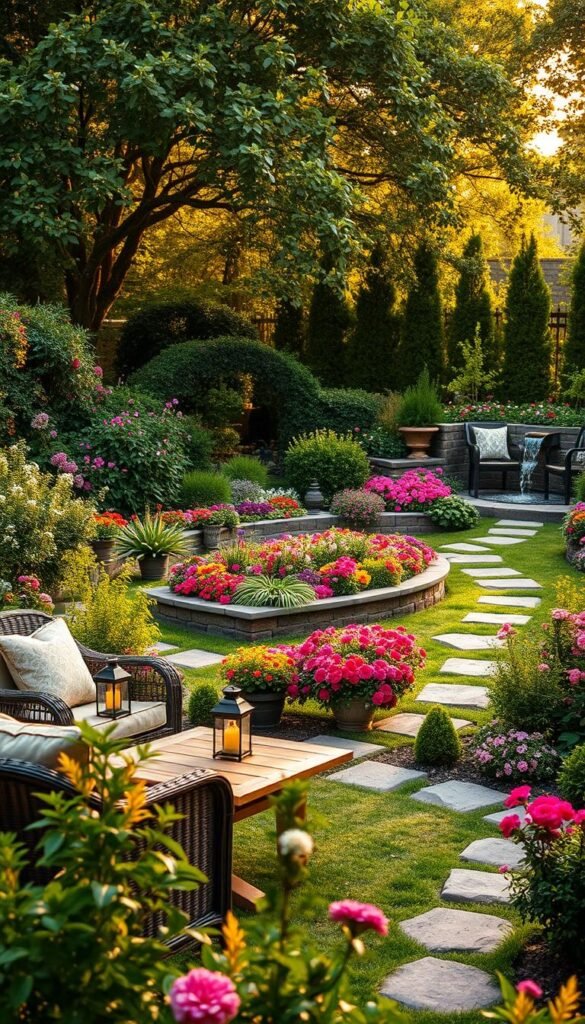Transforming your outdoor area into a personalized retreat combines style and practicality in ways that elevate daily living. A thoughtfully planned space not only boosts your home’s curb appeal but also becomes a versatile hub for relaxation and gatherings. Experts at ShrubHub emphasize that success starts with balancing visual charm and functional features like seating areas or accessible pathways.
Imagine stepping outside to a lush environment where every element serves a purpose. Whether you’re hosting summer barbecues or enjoying quiet mornings with coffee, your layout should reflect your lifestyle. Start by assessing sunlight patterns and soil quality—key factors that influence plant choices and placement.
Modern designs often blend weather-resistant furniture with eye-catching focal points, such as water features or decorative planters. For inspiration on creating cohesive aesthetics, explore our guide to elevating your outdoor space. This approach ensures durability while maintaining natural beauty through seasons.
Remember: low-maintenance plants and eco-friendly practices like mulching keep your sanctuary inviting without constant effort. By prioritizing both form and function, you’ll craft an area that feels uniquely yours—a true extension of your home.
Planning Your Outdoor Space: Vision & Layout
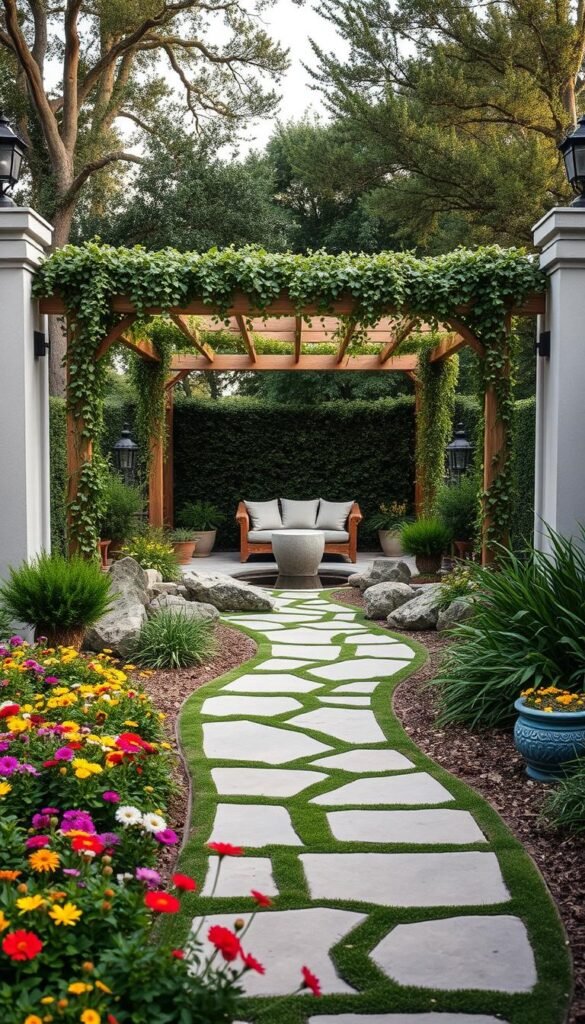
Effective outdoor design starts by mapping natural elements and personal needs. Before planting or building, take time to study your land’s unique features. This groundwork ensures every decision supports both beauty and daily use.
Assessing Your Space and Sunlight
Grab a tape measure and notebook to document your yard’s dimensions. Track sunlight patterns over three days—note where shadows fall at 9 AM, noon, and 3 PM. These observations reveal microclimates perfect for shade-loving hostas or sun-craving lavender.
Existing trees, slopes, or structures aren’t obstacles—they’re free design assets. A mature oak becomes natural shade for benches, while a gentle slope guides rainwater away from seating areas. Mark these features on your sketch as anchors for your layout.
Sketching Your Ideal Backyard Design
Turn observations into action with scaled drawings. Start by outlining permanent features, then add flexible elements like movable planters or modular seating. Leave 36-inch pathways between zones for comfortable movement.
| Element | Key Consideration | Optimal Placement |
|---|---|---|
| Dining Area | Evening shade | West side near kitchen |
| Herb Garden | 6+ hours sun | South-facing wall |
| Fire Pit | Wind protection | Northwest corner |
Leave room for growth—both plants and lifestyle changes. A play area today could become a meditation zone tomorrow. Use graph paper or free apps to experiment with layouts before breaking ground.
Selecting the Perfect Plants and Materials
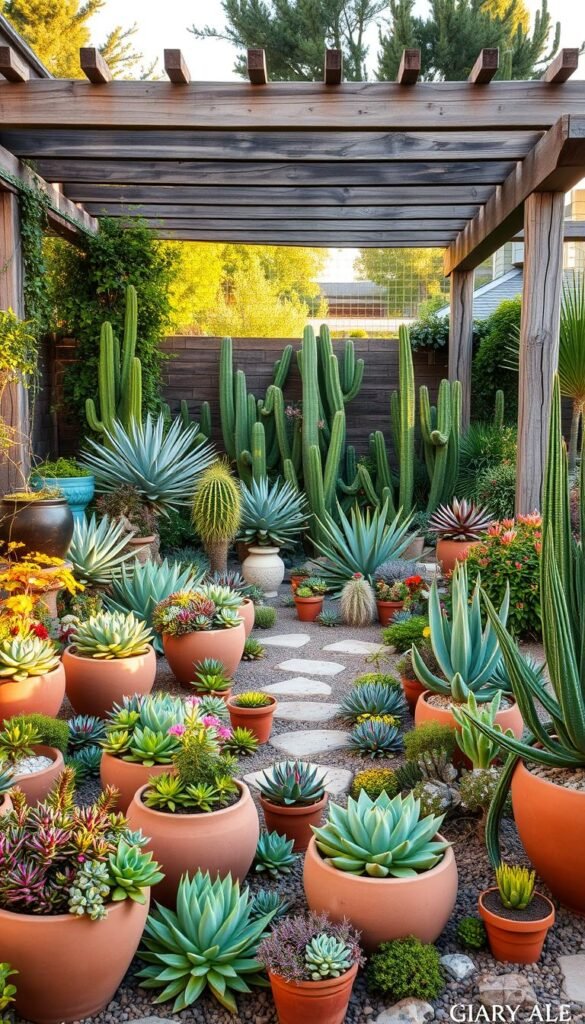
Crafting an inviting outdoor space begins with smart plant choices and durable materials that work together. Your selections should reflect local growing conditions while creating visual harmony between living elements and hardscape features.
Choosing Native and Drought-Tolerant Varieties
Native species like purple coneflower and switchgrass adapt effortlessly to your region’s climate. These plants need less watering and naturally resist pests. Pair them with drought-tolerant options such as sedum or Russian sage for texture that survives dry spells.
For year-round structure, mix evergreen shrubs with seasonal bloomers. A blueberry bush offers spring flowers, summer fruit, and fiery fall foliage. This approach keeps your space lively while supporting local pollinators.
Mixing Decorative Elements with Functional Materials
Choose surfaces that serve dual purposes. Crushed granite pathways drain rainwater while complementing wildflower beds. Weather-resistant cedar planters add warmth to herb gardens and withstand harsh sun.
Consider these combinations:
- Decorative mulch that enriches soil as it decomposes
- Recycled glass borders that sparkle in sunlight
- Permeable pavers that reduce runoff
Even small spaces shine with thoughtful pairings. Discover creative container gardening ideas for urban balconies that blend practicality with style. The right materials elevate your plants while simplifying upkeep.
Features to Enhance Functionality: Outdoor Kitchens, Fire Pits & More
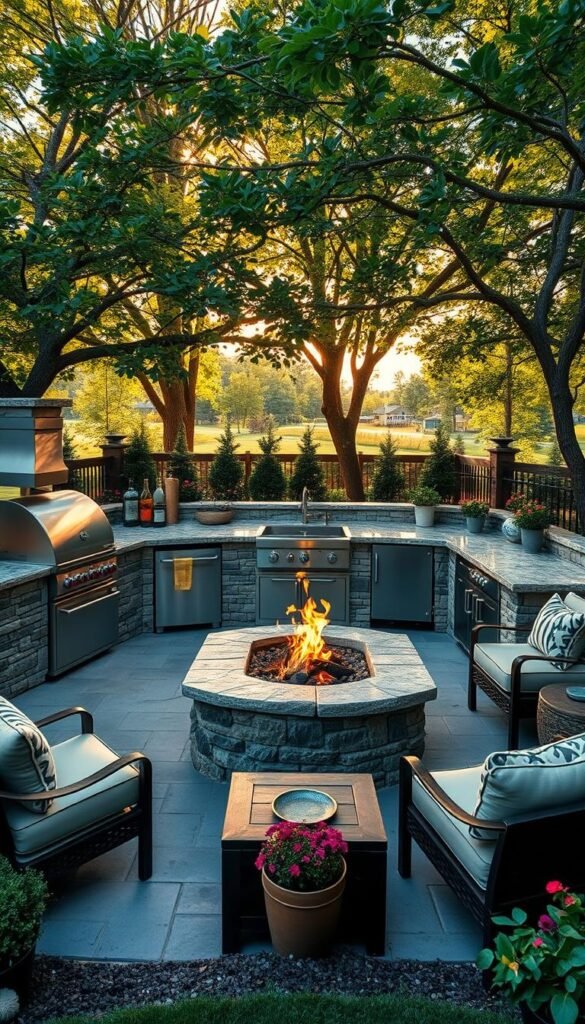
Your outdoor area becomes truly special when practical elements meet creative design. Smart features turn ordinary yards into multi-purpose hubs where memories happen. Let’s explore how to blend comfort and utility in ways that suit your lifestyle.
Designing Cozy Seating Areas and Dining Spaces
Start with seating areas that invite relaxation. Built-in stone benches or teak lounge chairs offer durable comfort. Arrange them around a central table for casual meals or facing a view for quiet moments. Add throw pillows in weather-resistant fabrics to boost coziness.
An outdoor kitchen transforms cooking into an experience. Include a compact fridge, stainless grill, and storage for utensils. Position it near your dining zone to streamline serving. “Guests naturally gather where food and conversation flow,” notes landscape designer Mia Torres.
Incorporating Lighting and Pathway Solutions
Layer your lighting for both safety and mood. Solar-powered path markers guide feet, while string lights create a starry canopy effect. Install dimmable LEDs under countertops for meal prep tasks.
Curved gravel pathways connect spaces while preventing muddy shoes. For evening charm, flank walkways with low-voltage lamps. A fire pit doubles as a heat source and social magnet—surround it with Adirondack chairs for year-round use.
| Feature | Key Benefit | Smart Tip |
|---|---|---|
| Outdoor Kitchen | Entertain while cooking | Add retractable awning |
| Fire Pit | Extends seasonal use | Use lava rocks for even heat |
| Path Lights | Prevents trips after dark | Space 6-8 feet apart |
Dream Backyard Garden Concepts: Merging Aesthetics with Function
The magic happens when your outdoor area becomes both eye-catching and effortless. Smart layouts marry visual charm with clever solutions—think benches that double as storage or trellises that shade seating zones. This balance lets you enjoy beauty without sacrificing comfort.
Your personal touch shines through multipurpose elements. Try these ideas:
- Vertical herb walls that flavor meals and screen neighbors
- Stone pathways directing foot traffic while framing flower beds
- Arbors draped in jasmine that perfume evening gatherings
Zoning creates flow between activity areas. Use these pairings to connect spaces:
| Zone Purpose | Design Element | Functional Benefit |
|---|---|---|
| Relaxation | Hammock corner | Reduces noise from play areas |
| Entertaining | Built-in seating | Maximizes guest capacity |
| Play | Artificial turf | Withstands heavy foot traffic |
Choose materials that age gracefully—weathering steel planters develop rustic patinas, while composite decking stays splinter-free. “Good design feels intentional yet adaptable,” says landscape architect Elena Morris. Start with structural plants for instant impact, then let perennials fill gaps over seasons.
Your final layout should invite exploration while feeling unified. Repeat colors in throw pillows and blooming shrubs. Match pathway materials to patio edges. When every detail pulls double duty, you create a space that’s ready for life’s moments—big and small.
Incorporating Decorative and Water Elements
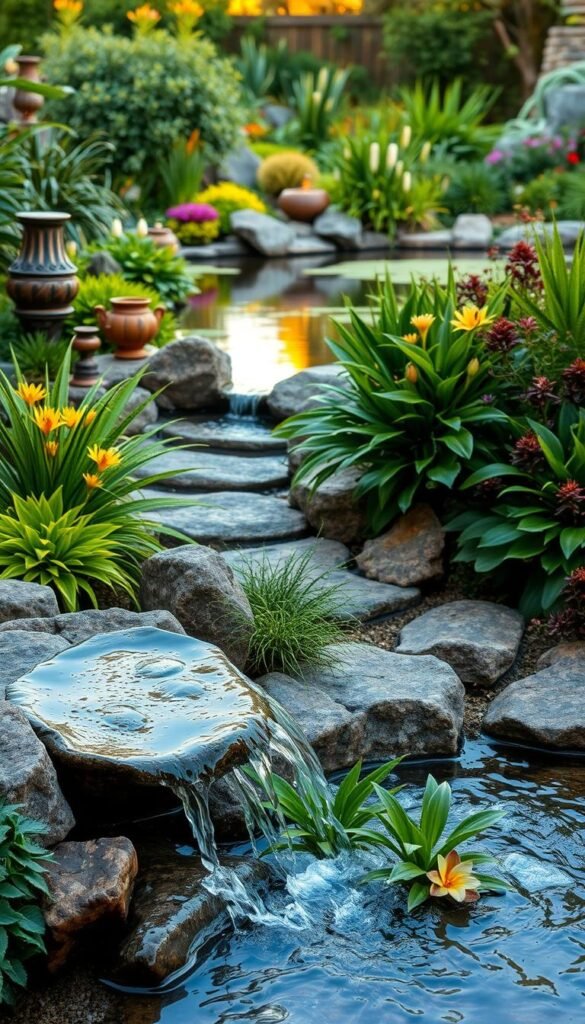
Your outdoor space gains new life when flowing water meets artistic accents. These elements work together to create a sensory experience that delights both eyes and ears. Thoughtful placement enhances your backyard’s atmosphere while solving practical needs like noise reduction.
Installing Fountains, Ponds, and Waterfalls
Water features bring motion and calm to your space. A small bubbling fountain masks traffic sounds while attracting thirsty birds. Larger ponds become habitats for frogs and dragonflies, adding ecological value. “Moving water creates instant tranquility,” notes landscape designer Clara Bennett.
Consider maintenance when choosing options. Recirculating systems with filters reduce upkeep for busy homeowners. Seasonal waterfalls can be winterized, while shallow birdbaths stay functional year-round.
Choosing Accent Pieces for Visual Appeal
Decorative elements should guide attention without overwhelming. A weathered bronze sculpture pairs beautifully with native grasses. Glazed ceramic planters add pops of color to herb gardens. Keep scale in mind—large yards handle statement pieces, while compact spaces shine with subtle accents.
Mulch and stones pull double duty. Crushed quartz defines pathways while reflecting moonlight. Cedar chips suppress weeds and release earthy scents after rain. These materials create cohesion between planting beds and hardscape features.
Sustainable Gardening and Low Maintenance Solutions
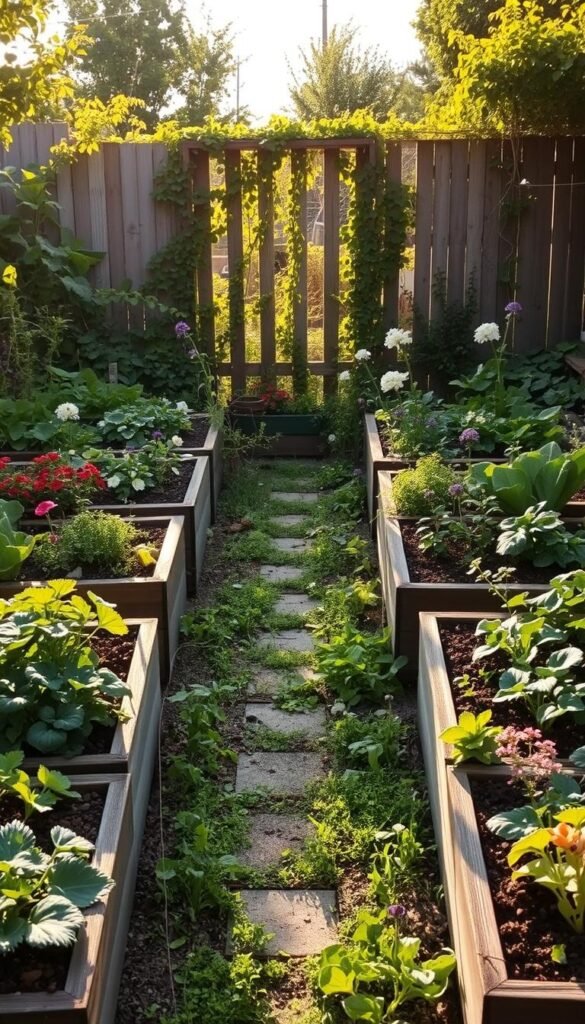
A thriving outdoor space should nourish both people and the planet. Let’s explore how smart choices reduce upkeep while supporting ecosystems. Start by rethinking water use—simple changes create big impacts.
Adopting Eco-Friendly Practices and Water Conservation
Drip irrigation systems deliver water directly to plant roots, cutting waste by up to 60%. Pair them with rain barrels to collect roof runoff—free hydration for thirsty flowers. Native species like milkweed or black-eyed Susans thrive without chemical fertilizers. “Sustainable gardens work with nature, not against it,” notes EPA horticulturist Dr. Liam Chen.
Try these water-wise strategies:
- Group plants with similar moisture needs
- Install smart timers that adjust to weather forecasts
- Use permeable paving to recharge groundwater
Using Organic Mulch and Composting Techniques
Wood chips or straw materials suppress weeds while locking in soil moisture. As they break down, they feed earthworms and microbes. Start a compost bin with kitchen scraps—egg shells, coffee grounds, and veggie peels become black gold for your beds.
| Material | Benefit | Best For |
|---|---|---|
| Grass Clippings | Quick nitrogen boost | Vegetable patches |
| Leaf Mold | Improves soil structure | Shrub borders |
| Pine Needles | Acidifies soil | Blueberry bushes |
Turn waste into resources—your garden becomes healthier each season. These ideas save time while creating habitats for butterflies and bees. Less work, more life!
Personal Style: Customizing Your Backyard Oasis
Your outdoor retreat should feel like an extension of your personality while serving your household’s daily rhythms. Start by identifying what makes your family thrive—do you host lively barbecues or prefer quiet evenings under string lights? This balance between shared joy and personal taste shapes every design choice.
Blending Modern Design with Rustic Charm
Mix materials to create visual intrigue that reflects your style. Pair sleek metal chairs with a reclaimed wood dining table, or surround a concrete fire pit with woven rattan stools. For inspiration on merging eras, explore our guide to achieving a timeless look through thoughtful contrasts.
Adding Family-Friendly Features and Fun Accents
Incorporate elements that grow with your crew. A built-in sandbox doubles as a hidden storage bench for toys. Hang a hammock between sturdy trees for lazy afternoons, or install a chalkboard wall near the patio for creative play. Durable, weather-resistant furniture ensures your space stays ready for spontaneous gatherings.
Remember: practical doesn’t mean plain. Colorful cushions brighten neutral seating areas, while solar-powered lanterns add whimsy to pathways. For more ideas on crafting a family-friendly oasis, consider flexible layouts that adapt as needs change. When every detail speaks to your life’s story, your outdoor haven becomes inseparable from your home.

